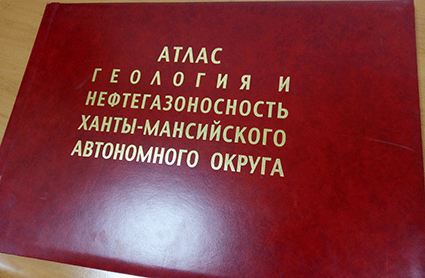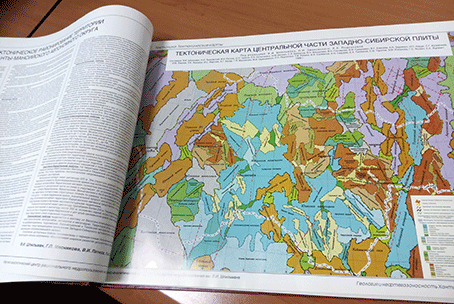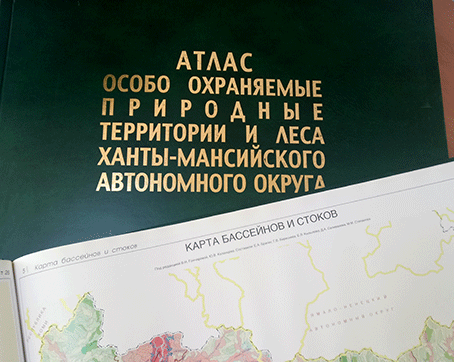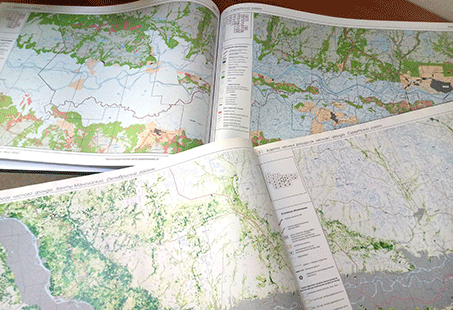Competencies

Cartographical production
ATLASES
Geology and oil and gas potential of the Khanty-Mansiysk Autonomous Okrug

The Atlas was prepared for the 10th anniversary of the National Enterprise KhMAO “V.I. Shpilman Research and Analytical Centre for the Rational Use of the Subsoil”. The «Atlas» generalizes extensive information on the geology and oil and gas potential of the sedimentary mantle and basement sediments, obtained for 50 years of West Siberia study, including research activities carried out at the V.I. Shpilman Research and Analytical Centre for the Rational Use of the Subsoil for the last 10 years. In preparation for the publication, modern cartographic computer technologies and professional software designed the Centre specialists were used.
The Centre integrated and numerous local databases are the information base for cartographic materials of the territory of the Khanty-Mansiyk Autonomous Okrug, the creation and use of these are an important function of its laboratories. Computer mapping was carried out by software products: Arc View (ESRI), TNTmips (MicroImages). Most maps are prepared with Sigma, GST software packages. Geological cross sections, correlation patterns are prepared in PlotLog software package, seismic time cross sections are prepared by Landmark software packages.
Maps, plots are grouped by sections and followed by the explanatory text. The sections are indicated in the table of contents.
The Atlas comprises eight sections.
Section 1 provides a physiographic map. It includes a digital terrain model prepared in the GST software package based on the U.S. Geological Survey of 1996 and well floor elevations. It is followed by an overview and photographs showing the landscape of different areas of the territory.
Section 2 contains maps of the exploration of the territory by drilling and seismic works. The map of exploration drilling maturity shows wells penetrated Bazhenov suite with seismic reflection interface “B”, bed Ju2-3 which are regional oil reservoirs of Middle Jurassic cross section, Paleozoic, Triassic deposits with help of which cross sections of the Lower and Middle Jurassic and pre-Jurassic deposits can be analyzed.
The areas covered by seismic exploration up to 1980, 1980-1990 and post-1990 are showed on the Map of seismic work maturity of the territory.
Seismic surveys were mainly carried out by seismic reflection method to 1970. From 1970 the implementation of the common depth point method started. This method became the main from 1976.
Section 3 contains fragments of regional seismic profiles numbers 4, 5, 6, 9 and 19 crossing Frolovskaya and Krasnoleninskaya oil and gas areas.
The wells which are not more than 1 km apart from the profiles are shown on the cross sections. Well logging records (resistivity logging and spontaneous potential log) of the wells are shown at time-scale.
A horizontal scale is 1:400,000, a vertical scale is 2 cm: 0.1 seconds. Stratigraphic reflection horizons were harmonized with horizons limiting clinoforms of the Neocomian age. Three structural maps for seismic level reflectors (M, B, A) and brief surface characteristics are given in the same section.

Section 4 contains a new tectonic map of the central part of the West-Siberian Plate, under the editorship of V.I. Shpilman, N.I. Zmanovskiy, L.L. Podsosova, on the scale of 1:2,000,000, 1998.
New methodological methods were used such as identification of the regional background from the structural maps of horizon B, mathematical calculations of the paths of planetary Earth Stresses crossing the territory of the West Siberian Plate. This allowed identifying of geological blocks with different material composition of pre-Jurassic deposits and different development in Mesozoic-Kainozoic time.
The map shows new tectonic elements such as Tursunskiy, Bakhilovskiy megalithic banks, Serginskaya elevation zone, a series of ridges on the northern extension of the Verkhnedemyanskiy megalithic bank, benches, and saddles of all kinds. A new structure of the previously identified Vneshniy Belt is presented. Three structural stages (Paleozoic, Permo-Triassic and Mesozoic-Kainozoic) are given.
Anomalies were considered on gravity and magnetic maps, as well as 6,500 well drilling data. During the zoning, the principle of 100% separation of superorder structures and first order structures was used.
The tectonic map is followed by insert maps showing the structure of large tectonic elements where numerous oil fields are discovered, and a map of planetary stress fields reflecting the Earth Stresses and the spread of four wave systems: East-West trending, North-South trending, sub-Uralian and South-Eastern. The evolutions of the tectonic, structural geometry in the Jurassic are shown on thickness maps of the Jurassic.
The new tectonic map is added by a plot of the structure of pre-Jurassic compositional complexes of the territory of KhMAO, which shows the zoning of the territory according to the age and material composition of the Paleozoic basement and according to the thikness of the Permo-Triassic intermediate complex. Maps of gravity anomalies in the edition of Graaf Hunter and isodynes of magnetic field incremental are presented. Taking into account these maps, drilling samples and seismic maps on seismic reflection interface “A”, a new structural map of the cap rock of the pre-Jurassic formations is prepared, added by a plot of the fault-block structure of the surface topography of the pre-Jurassic deposits.
The tectonic complexity of the West Siberian Plate is confirmed by the identified blocks on the satellite images and the faults of different orders.
Section 5 deals with the construction of five oil and gas reservoirs: Lower Jurassic, Middle Jurassic, Upper Jurassic - Vasyugan, Upper Jurassic clay, Neocomian clinoform, connected to BV6-9 and Achimov strata.
The Shaimskaya zone (Upper Jurassic complex) rich with deposits is analyzed. The section is followed by isopachyte maps, correlation patterns, and typical cross sections. For the Lower Middle Jurassic deposits, recommendations for improving the stratigraphic sectional planes approved in 1991 are given; basic cross sections with determined producing reservoirs and their indexing are given. A map of oil and gas zoning with determined three new oil and gas areas (Vostochno-Uralskaya, Krasnoleninskaya and Prieniseiskaya) and six new oil and gas regions (Noyabrskiy, Serginskiy, Priobskiy, Bakhilovskiy, Sabunskiy and Karalkinskiy) is presented. The map shows the discovered fields, boundaries of oil and gas areas and oil and gas regions of the Okrug. The map is followed by the descriptive information of total oil and gas regions and the feasibility of the identification of new objects. The revaluation of oil and gas potential of KhMAO outlying districts was completed.
The map of oil and gas zoning is followed by oil and gas reservoir tables, identified the lithologic and facies characteristic of the cross sections and the distribution of discovered deposits by depth, indicating the age and the approved indexing of productive formation for each oil and gas area.

Lithologic and stratigraphic cross sections are given for each oil and gas area and oil and gas region with lithological structure of productive formation, oil and complexes and cap rocks above them as well as the brief characteristic.
Section 6 contains maps of the structure of oil and gas complexes such as the Upper Jurassic - Vasyugan, the Upper Jurassic - Bazhenov and Abalak clay, the Middle Jurassic, the Lower Jurassic and the Neocomian clinoform. The maps show the contours of discovered deposits, indicating the productive formations, the contours of prospective traps, and the boundaries of clay reservoir replacement and unlocking cap trap. The features of distribution of the Achimov thickness, the edge of shelf are additionally shown for clinoform complexes. The maps are followed by a series of geological cross sections of productive deposits of Jurassic and Cretaceous. Three paleogeographic plots are given for productive formations of the Lower Jurassic (Yu10-12).
Section 7 deals with the structure of individual deposits of identified oil and gas regions. Oil reserve estimation maps for individual deposits, geological sections, and a brief description of deposits and main deposits are given.
Section 8 contains maps of the potential of oil and gas reservoirs for the Lower, Middle and Upper Jurassic complexes, discovered deposits or deposits, prospective traps, the features of the distribution of complexes and the boundaries of the individual clay reservoir replacement are shown. All maps and plots are created on the basis of the structural maps. The resource density map was carried out for the Lower and Middle Jurassic.
The brief characteristic of oil and gas reservoir potential is given for total oil and gas complexes. The geological cross sections of individual groups of fields, fragments of small-scale satellite images are shown and oil forecast for individual areas are given.
The conclusion contains the results of the program of geological exploration activities of 1996-2002 and oil exploration priorities at the territory of KhMAO.
An important feature of the Atlas is its detail and visual aspects, a considerable amount of practical and scientific materials, allowing to see the structure, morphology of the main oil and gas objects, to determine the impact of various processes on the formation of oil and gas deposits.
The Atlas is intended for researchers working at the territory of the Okrug, postgraduate students and students specialized in geology.Specially protected natural areas and forests of Khanty-Mansiysk Autonomous Okrug

The Atlas «Specially protected natural areas and forests of KhMAO» is published for the first time. «Atlas» is the collective work of specialists of V.I. Shpilman Research and Analytical Centre for the Rational Use of the Subsoil for collection, systematizing, data analyzing from natural resource users and subsoil users and the information on specially protected natural areas and forests of KhMAO is generalized, processed and derived after many years of study (1994-2004). First of all, natural objects with a protected status: wetlands, the flood plain of the Ob and the Irtysh within the Autonomous Okrug, territories of traditional natural resource use, nature reserves, special nature reserves, nature parks, nature monuments, cedar woodlands, pine nut harvesting zones, spawning zones, protective and restricted belts and objects for industrial infrastructure that have an impact on the environment are provided in the Atlas.
A special attention was paid to the wetland mapping as natural objects of the high environmental importance.
According to the data of the Committee on Land Resources and Land Management as of 01.01.2003, wetlands account to 38.3% of the Okrug area.
The wetlands within the West-Siberian Lowland have been previously mapped. In 1976 the map of the West-Siberian Plain vegetation on the scale of 1:1 500,000 was published with the determination of zonal types of wetlands on the scale of 1:12,500,000, developed by the Institute of Geography of Siberia and the Far East of the AS Siberian Branch of the USSR under the general supervision of the academician V.B. Sochava.
The second issue of the Atlas of Tyumen region, developed by the Tyumen complex expedition of the Geographical Faculty of M.V. Lomonosov Moscow State University together with a number of All-Union, national and regional scientific, production and planning organizations published in 1976 contains the map of the of natural condition assessment for the development of oil and gas fields on the scale of 1:4,000,000. The map presents wetlands classified by the degree of complexity for the construction of the field facility and the pipeline with wetland type identification.

The waterlogging process causes changes in the wetland features. A comparative analysis of the current state of natural water bodies obtained from the interpretation of space images for 1999-2001 and the topography of 10-20 years ago showed a significant change in the wetland contours on area changing.
A small scale of the thematic maps does not provide a comprehensive picture of the wetland contours. The industrial and economic development of the Okrug, often associated with land drainage, and the wetland development, leads to changes in the object contours and to clarify the wetland contours on the medium scale of 1:100,000 and 1:200,000 in regular manner.
The Atlas was created on the basis of integrated and local databases of the Centre, the results of the interpretation of satellite images, and a generalization of published, archive, statistical reporting materials provided by the regional land resource committees, The Head Department of Natural Resources and Environmental Protection of the Russian Ministry of Environment and Natural Resources of the Russian Federation for KhMAO - Yugra, the Department of Oil, Gas and Mineral Resources of the KhMAO - Yugra.
«Atlas» comprises two sections.
A Map of specially protected natural areas and forests of Khanty-Mansiysk Autonomous Okrug presents in the Atlas section 1. The map was prepared for «Atlas». It presents natural objects: forests, rivers, lakes, wetlands, the flood plain of the Ob and the Irtysh, forests of the 1st group of protected categories: pine nut harvesting zones, boundaries of protective and restricted zones, boundaries of spawning zones, cedar woodlands. The administrative division and infrastructure facilities of the Khanty-Mansiysk Autonomous Okrug are presented. Objects of protected areas and territories of traditional natural resource use (tribal lands) are mapped.
The contours of wetland and the flood plain the Ob and the Irtysh, as well as the infrastructure, were mapped with help of space imagery interpretation from the American satellite Landsat-7.
The data are given on the scale of 1:200,000. The map sheets are grouped by the administrative regions of Khanty-Mansiysk Autonomous Okrug.
The Atlas section 2 contains a Map of the forest resource assessment of the Khanty-Mansiysk Autonomous Okrug forest fund on the scale of 1:500,000. The map was prepared for «Atlas» on the base of information of Federal State Unitary Enterprise «ZAPSIBLESPROEKT» adapted from forest fund management for 1995-2001. The basis of the map was data on timber resources in forest stratums. Prospective areas with significant proved reserves of forest fund are mapped. It is planned to involve these plots in economic activities in 2005-2015.
The computer cartography was carried out by software products: MapInfo, ER Mapper (Earth Resource Mapping), TNT (MicroImages).
The Atlas «Specially protected natural areas and forests of Khanty-Mansiysk Autonomous Okrug» will be useful for the administration and oil and gas companies developing the subsoil.Scientific and practical activity
Other activity




















